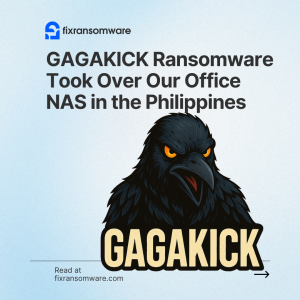When staff arrived at the office in the Philippines one Monday morning, everything looked normal—until they tried to open shared folders. Project files would not open, finance spreadsheets showed errors, and HR archives had strange new names. A quick check on the NAS revealed that almost every file had a new extension like “.gagakick” and a ransom note sat in each main folder. It was GAGAKICK Ransomware, and the entire office NAS had been taken over.
This story walks through the key steps the IT team and management followed to contain the damage, recover critical data, and avoid paying the attackers.
Containing a GAGAKICK Ransomware NAS Incident
The first reaction was not to rebuild the NAS. Instead, the team focused on containment.
- They disconnected the NAS from the network.
- They disabled remote access and VPN accounts that looked risky.
- They stopped users from trying random “repair tools” on encrypted files.
- They saved several copies of ransom notes and a few encrypted files as evidence.
Because of this, GAGAKICK Ransomware could not continue to spread or re-encrypt fresh data from laptops and servers. The NAS was isolated, frozen in the state it was found.
Explaining the Impact to Management
Management in the Philippines office needed a clear view of the situation. So the IT lead prepared a short, focused status:
- What was affected: the central NAS holding project documents, invoices, and scanned contracts.
- What was still working: email, core business apps, and cloud services.
- What they did not know yet: whether any usable offline backup existed.
This simple summary helped managers decide priorities. They agreed that restoring finance and active project folders came first, while less critical archives could wait. As a result, everyone pulled in the same direction instead of asking for everything “right now”.
Technical Assessment of the GAGAKICK Ransomware Attack
Once the NAS was offline and management aligned, the team started a structured technical assessment.
They documented:
- NAS model, firmware version, and storage layout.
- Which shares were encrypted and which, if any, remained untouched.
- When users first noticed slowdowns or strange errors.
The IT team then collected a small encrypted sample and logs. At this point, they reached out to specialists via FixRansomware.com and submitted samples through the secure portal at app.FixRansomware.com. The goal was to confirm the GAGAKICK Ransomware behaviour, estimate recovery chances, and avoid steps that might destroy remaining structure in the data.
For broader best practices, they also reviewed guidance like the official CISA Ransomware Guide, which reinforces the same “isolate, assess, then recover” sequence.
Designing a Safe NAS Recovery Plan
With more information, the team and external experts built a realistic rescue plan:
- Work from copies, not the only NAS volume
The storage was cloned so every recovery attempt happened on a copy. Therefore, if a tool or script misbehaved, the original evidence and data were still safe. - Restore the most critical folders first
Finance, active project folders, and legal documents took priority. Less important archives and old backups were placed in a lower tier. - Combine backups and targeted decryption
In this case, some older backups survived on a separate device. Newer, more recent data existed only in encrypted form. By combining clean backups with guided decryption of selected folders, the team rebuilt a usable, up-to-date view of operations.
Throughout the process, they documented each major step: what tool they used, which folder they tested, and which version they kept. This log later proved useful for both internal audit and external partners.
Communication With Users and Stakeholders
While technical work continued, clear communication kept chaos under control.
Staff were informed that:
- The NAS had been hit by GAGAKICK Ransomware.
- Some documents would be temporarily unavailable or restored from older versions.
- They should not forward ransom notes or contact the attackers directly.
Clients received a simple, honest explanation if document delivery was delayed. Meanwhile, finance and legal teams tracked any manual corrections made during the downtime so nothing was lost on the accounting side.
Hardening the Environment After the Attack
After the NAS in the Philippines office came back online, the team focused on preventing a repeat.
They:
- Closed unnecessary exposed services and hardened remote access.
- Tightened password and MFA policies for admin accounts.
- Improved backup strategy with at least one offline or offsite copy.
- Planned simple incident response drills so next time, everyone knows their role.
By treating the GAGAKICK Ransomware incident as a forced audit, the company ended up with stronger security, clearer processes, and a tested recovery playbook instead of just a painful story.


